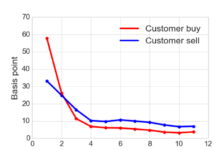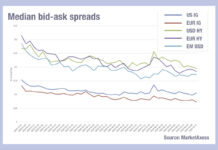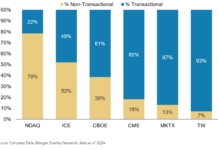Buy-side bond traders are facing a considerable challenge in matching their investor’s demand for fixed income assets as equity markets plummet. Volumes are up, but that does not represent increased liquidity, and traders are reporting markets with all bids and no offers.
One Europe-based trader with over 30 years in the fixed income markets said, “I am not sure I have seen it like this. Very unique.”
Another head of trading observed, “There is no liquidity.”
With bank risk provision dropping off considerably, buy-side firms are stepping up to the plate as price makers. Banks not able to support asset managers may find they are putting longer term relationships at risk.
Electronic platforms are carrying additional liquidity. MarketAxess is seeing significant ADV in Open Trading, its all-to-all trading network, across all core products. The firm also reported record monthly average daily credit trading volume for February, including across US High Yield, Eurobond and US Treasuries.
A spokesperson for MarketAxess says, “In a market that can be one-sided and potentially disorderly, diverse liquidity provision and a broad network of participants can help to mitigate dislocation. We’re seeing Open Trading playing a very key part of the risk transfer mechanism for clients and dealers at present, as it allows investors to act as both liquidity providers and takers.”
MTS BondVision is reporting an ADV for March is up 52% year-on-year. Tradeweb is reporting elevated portfolio trading activity and strong volumes in both compression and list trading, and in the final week of February saw a record ADV of US$1.1 trillion per day. New records were seen across several cash products, including U.S. Treasuries, Mortgages, U.S. and European Credit, Repo and European ETFs.
Pre-trade data and analaytics provider, BondCliq reported that in the US corporate bond market, the ADV of the 35 trading days before 24 February 2020 (pre-COVID-19) was US$35 billion. Between 24 February to 11 March, US corporate bond market ADV was around US$55 billion, a 53% increase in daily transaction volume.

“The extra US$20 billion in ADV in US corporate bond market trading volumes is not necessarily an indication of plentiful liquidity,” wrote Chris White, CEO, in an analyst note. “There are ~40,000 CUSIPs in the corporate bond market and under normal conditions, concentration has always been a defining feature of trading activity, but it’s worth looking at magnitude of this concentration in times of market stress.”
He notes that the breadth of CUSIPs trading has reduced in all areas apart from the most highly traded quintiles of Consumer Discretionary and TMT sectors, while double figure volume growth was experienced across all sectors and activity, indicating significant concentration of activity, over breadth of activity.
US treasury markets have seen volumes rockets – between 2 March and 12 March Brokertec reported volumes for Treasury Actives up over 90% above the 2019 average.
However, liquidity in the broader market has been terrible.

Mark Cabana, rates strategist at Bank of America Securities, noted on 12 March that US Treasury market functioning had materially deteriorated over recent days, with the 30-Year bond yield increasing 11bps on 11 March while the S&P 500 declined 5%.
“In a risk off environment it would be expected to see UST yields decline; yields appear to have been overwhelmed by liquidity concerns yesterday,” he wrote, noting the situation is likely to require a rapid and large policy response from the US Treasury or Federal Reserve.
Due to the US Treasury market’s position as the major risk free rates market, he notes large scale illiquidity makes it hard for other markets to price effectively.
“[It] could lead to large scale position liquidations elsewhere, ex. agency MBS, credit, equities. It would also increase the cost and reduce the ability for the US government to fund itself. This would make it increasingly difficult to provide much needed fiscal help to combat the COVID-19 public health emergency.”
The Fed’s policy response on the 12 March was to extend the tenor of repo operations from overnight and two week tenors out to one month with the first at Us$50 billion in size on morning of 13 March, priced at 1-month fed funds OIS + 5 bps.
“The action shows that the Fed is sensitive to underlying market conditions and working to improve market functioning,” noted Cabana. “However, it may not be enough. We are concerned that the size of this repo operation may not be large enough to stabilize the cheapening in UST securities and materially improve Treasury market liquidity. We believe it may take a more forceful action from the US Treasury or Federal Reserve to act as a ‘circuit breaker’ in these illiquid Treasury markets. Specifically, we think there is a case for official sector policy action to support market functioning. Two options for consideration include, the Fed re-starting UST quantitative easing, the US Treasury conducting ‘buyback’ operations. We favour the latter option.”
©The DESK 2020
TOP OF PAGE
























